Crowd Reactions: Understanding and Using Public Response Sounds
Updated On: October 23, 2025 by Aaron Connolly
Types of Crowd Reactions
Crowd reactions in esports really make live tournaments come alive. You feel the electricity when fans roar during clutch plays or gasp when the underdogs do something wild.
Cheers and Applause
Cheers and applause are the most positive crowd reactions you’ll hear at esports events. They break out when someone pulls off an amazing play, a comeback happens, or hometown heroes pull off a slick move.
The crowd’s energy doesn’t just appear out of nowhere. It usually starts with a few fans spotting a good play, and then everyone else catches on.
You’ll hear the loudest cheers during:
- Ace rounds in CS2
- Baron steals in League of Legends
- Perfect combos in fighting games
Different games have their own cheering rhythms. In MOBAs, the crowd sometimes waits a second to react since team fights can be confusing at first. Fighting game fans, though? They react instantly to anything flashy.
Stadium design matters, too. Enclosed venues trap sound and make everything louder. Outdoor events, even with bigger crowds, can actually sound quieter.
Booing and Jeering
Booing really ramps up the tension in competitive gaming. Fans boo controversial plays, teams they don’t like, or when referees make questionable calls.
Booing does a couple things at once. It shows loyalty to a team, but it also puts psychological pressure on the opponents.
Fans usually boo because of:
- Pause abuse or annoying delays
- Unsportsmanlike behaviour
- Referee decisions that feel unfair
- Dominant teams that folks are tired of seeing win
Different regions have their own styles. Korean fans usually keep things polite, even when they’re upset. Brazilian crowds? They’re not shy about letting players know how they feel.
Players handle booing in their own ways. Some feed off the energy and play even better. Others lose focus with so many people rooting against them.
Gasps and Surprise
Gasps are those moments when something truly unexpected happens and the whole crowd is caught off guard. It’s a split-second, honest reaction before people even have time to think.
People don’t plan to gasp—it just happens. It’s automatic, unlike a cheer or a boo.
Crowds gasp when:
- Underdogs upset favourites
- Technical failures mess with the game
- Unbelievable solo plays come out of nowhere
- Surprise roster changes get announced
Timing is everything here. When thousands gasp together, it’s unforgettable. Sometimes those gasps even end up in highlight reels.
Usually, gasps turn into something else fast. Surprise gives way to cheers, applause, or just stunned silence, depending on who you’re rooting for.
Laughter
Laughter gives everyone a break from the tension and helps build a community vibe. You’ll hear it during tech hiccups, silly player mistakes, or when casters crack a good joke.
Not all laughter is the same. A gentle chuckle at a small mistake feels different from the kind of laughter that erupts when something truly ridiculous happens.
Crowds laugh at:
- Silly player errors (like walking into a wall)
- Funny technical glitches
- Witty caster lines
- Playful moments between players
Timing matters. Laughing with the players feels supportive, but laughing at them during a serious blunder? That can sting.
Laughter helps everyone reset after a stressful match. It lightens the mood so people are ready for the next round.
Key Elements That Shape Crowd Reactions
A few core things shape how crowds react at gaming events. The emotional charge of the moment, the situation in the match, and the timing all come together to create those massive eruptions of noise.
Emotion and Intensity
Emotional contagion is what drives those huge crowd reactions. One person jumps up after a wild play, and suddenly everyone around them is up too.
The build-up feels different depending on the game. In League of Legends, people might be quiet for a while, then explode when a fight breaks out. Counter-Strike fans react instantly to clutch moments.
Shared investment makes everything louder. If fans are rooting for their home team or favourite player, every play means more. That’s why the cheers and groans sound so intense.
You see this at international events. UK fans at ESL One Birmingham get way louder when British players are on stage. That local connection makes every moment feel huge.
Fans who’ve followed a player’s whole journey from amateur to pro react more strongly than casual viewers. It’s just more personal for them.
Event Context
The tournament stakes totally change how crowds react. A slick move in group stages gets a nod, but do the same thing in a grand final and the place erupts.
Narrative context matters too. When an underdog starts beating the favourite, the crowd often switches sides. Everyone loves a good David vs Goliath story.
The venue size changes the vibe. Smaller venues feel intimate, and reactions spread fast. Big arenas need bigger moments to get everyone going.
Prize money raises the stakes. Fans know when a single mistake could cost a team £50,000. That knowledge makes tense moments even more gripping.
Crowds act differently at online events compared to LANs. In-person tournaments with players right there create a much more genuine energy.
Timing and Cues
Visual and audio cues get instant reactions. Certain sounds in Dota 2 tell fans exactly what’s happening, sometimes even before they see it.
Commentators play a big role. When casters hype up a moment, the crowd picks up on it. Good casters know just when to ramp up their excitement.
Momentum shifts are crowd fuel. If a team’s down 0-2 and suddenly wins a few rounds, the energy skyrockets.
Technical pauses can actually build hype. When the game stops at a crucial point, the tension can get almost unbearable. Fans use that pause to process and get ready for what’s next.
The element of surprise always multiplies crowd reactions. Out-of-nowhere strategies, unknown players making huge plays, or shocking upsets stick in everyone’s memory.
Applications of Crowd Reactions in Media
Crowd reactions have become a staple in entertainment, from movies to video games. AI now creates audience sounds that change in real-time, making virtual crowds sound almost real.
Film and Television
Filmmakers and TV producers use crowd reactions to set the mood and help viewers connect emotionally. Directors now use AI crowds even before filming finishes, just to see how scenes might land.
Cost-Effective Production Solutions
- Virtual crowds cut out the need for hiring extras
- AI creates fresh reactions for every scene
- Post-production tools make it easy to drop crowds into edits
Platforms like Netflix use digital crowds to localise shows. A comedy might have British laughter for UK viewers and American laughter for US audiences.
Key Benefits for Creators:
- Budget savings: No need to feed or wrangle extras
- Flexibility: Change crowd size or vibe after filming
- Consistency: Keep reactions steady across takes
Studios say they save up to 40% on crowd scenes with AI. That’s a game-changer for indie filmmakers who could never afford big background crowds.
Video Games
Game developers use crowd reactions to make stadiums feel alive and matches feel real. AI now fills stands with fans that actually react to what’s happening on the field.
Real-Time Reaction Systems Sports games look at what’s happening and trigger different crowd sounds. A game-winning goal sounds totally different from a regular play.
AI spectators act more human than ever:
- Proximity awareness: Fans close to the action go wild
- Emotional carryover: The crowd’s mood sticks around between plays
- Cultural authenticity: Cheers and chants match the sport and region
Implementation Benefits:
- More immersive gameplay
- Atmosphere that shifts as the match unfolds
- Faster crowd animation for developers
Esports tournaments use virtual crowds when real fans can’t attend, so players and viewers still get that competitive buzz.
Live Broadcasts
Broadcasters use AI crowd sounds to boost live shows, especially when there aren’t many people in the audience.
Interactive Broadcasting Features
- Generate crowd noise based on how viewers react online
- Use social media trends to shape audience sounds
- Customise reactions for different show segments
Sports broadcasts really benefit from this. When stadiums are half-empty, AI fills the seats with virtual fans who cheer and boo in real time.
Practical Applications Include:
- Award shows: Add applause for remote ceremonies
- Talk shows: Create a studio vibe from home
- Sports coverage: Make empty arenas feel packed
The tech plugs right into existing broadcast gear. Producers can tweak the crowd’s energy with just a few clicks.
Broadcasters say viewers stick around longer when shows have realistic crowd sounds—even if everyone knows it’s digital.
Sourcing Crowd Reaction Sound Effects
Looking for good crowd sounds? It helps to know where to look and what you’re allowed to use. Free sites are fine for basics, but pro libraries give you polished audio with clear rights.
Royalty-Free Sound Libraries
Sites like Pixabay and Uppbeat are great for free crowd sounds. They’ve got hundreds of clips and don’t charge anything.
Pixabay has more than 970 crowd effects you can grab right now. Quality varies, but they’re fine for YouTube or small projects.
Uppbeat is aimed at creators, with crowd sounds cleared for social media and streams.
Most free libraries don’t allow commercial use. Always check the licence before using them in anything you’re getting paid for.
Quick tip: Download a few cheers and applause tracks to see what fits your project before you pay for anything.
Soundboards and Instant Play Tools
Soundboards let you play crowd noises on the fly during streams or events. Lots of creators use these for instant audience reactions.
Browser soundboards run straight in your browser—no download needed, just click and go.
Mobile apps like Instant Buttons let you play crowd sounds from your phone. Handy for events or presentations.
Heads up: Free soundboards sometimes use low-quality or even copyrighted clips. Double-check the rights if you’re using them in a commercial project.
Popular streamers often share their soundboard setups, usually with crowd sounds that won’t get you in trouble for copyright.
Professional Audio Platforms
Artlist and Epidemic Sound offer top-notch crowd sounds with commercial licences. Expect to pay around £10-30 a month for unlimited downloads.
Soundrangers sells big packs, like their 272-sound audience library for £129. You get different formats and pro-level tagging.
Pro platforms give you:
- Multiple audio qualities (44kHz to 96kHz)
- Different crowd sizes and venues
- Broadcast-ready licences
| Platform | Monthly Cost | Commercial Use | Audio Quality |
|---|---|---|---|
| Artlist | £16.60 | Full licence | Broadcast ready |
| Epidemic | £12.50 | Full licence | High quality |
| Soundrangers | One-time £129 | Full licence | Professional |
Try free sounds first to see what works, then move up to professional platforms if you need broadcast quality.
How to Record Authentic Crowd Reactions
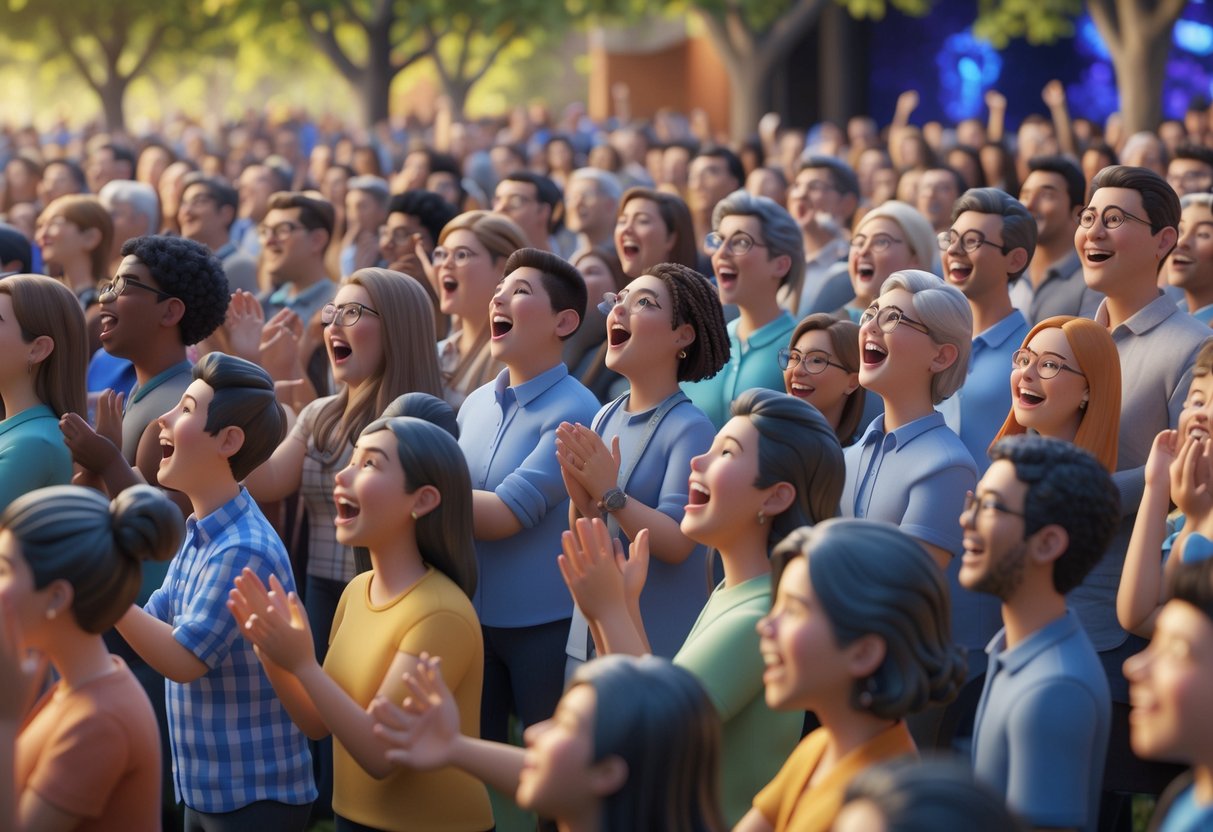
If you want to capture real crowd reactions, you’ll need a good location, the right equipment, and a few tricks to keep the energy natural. The most honest recordings happen when people don’t notice the mics and your gear can handle those sudden bursts of noise.
Choosing Venues and Events
I usually prefer indoor venues for crowd recording. Concert halls and theatres give you better acoustics and spots to hang mics overhead.
Small or mid-sized venues make crowd reactions clearer. Big stadiums? Too much echo, and it’s a pain to separate the audience from the blaring sound system.
Honestly, you might want to skip outdoor gigs at first. Wind can ruin your audio, and there’s nowhere solid to hang mics without proper infrastructure.
Pick events with obvious reaction points. Comedy shows are fantastic—laughter stands out and is easy to record. Sports events offer cheers and groans, usually right when you’d expect them.
Classical concerts have quieter crowds, so your gear won’t max out. Rock shows crank up the energy, but you’ll need to brace for much louder reactions.
| Event Type | Best For | Challenges |
|---|---|---|
| Comedy shows | Clear laughter | Quiet between laughs |
| Rock concerts | High energy | Very loud PA system |
| Sports events | Varied reactions | Unpredictable timing |
| Theatre | Natural responses | Mixed volume levels |
Recording Equipment Tips
I always reach for omnidirectional microphones when I want to catch the whole crowd. They grab sound from everywhere, not just one spot.
Shotgun mics come in handy if you want to block out chatty folks nearby. They’re a lifesaver in smaller rooms where people can’t stop talking.
Stick with identical microphone models for stereo setups. Using different mics makes the audio uneven, and fixing that later is a headache.
Set up heavy compression or limiting on your crowd mics. Crowd reactions spike fast, and without this, your recordings can get trashed.
If your mics have low-frequency rolloff, turn it on. It cuts out rumble and bass that muddy up the reactions.
Hang your mics at least three feet above the audience. Going higher helps you dodge picking up too much individual chatter.
I like to record one clean feed from the mixing board, plus an ambient track from the crowd mics. Later, you can blend them however you want.
Capturing Natural Atmosphere
Set your mics halfway between the stage and the back wall. This spot usually catches the whole audience without too much noise from the stage.
Angle the mics toward each other across the crowd, then point them down toward the middle. You’ll get a nice stereo image this way.
Stay alert for big moments—start recording before they hit. Comedy punchlines and big sports plays usually give some warning if you’re paying attention.
Skip X/Y or ORTF stereo techniques for crowd sounds. Those pick up too much room and not enough focused reactions.
Grab plenty of B-roll between main reactions. Murmurs and shuffling feet help make the space feel alive.
For mono tracks, angle one mic toward the stage and the other away. You’ll get a richer sound than if both face the same way.
Keep recording longer than you think. Crowd energy rises and falls—if you stop too soon, you’ll miss the natural vibe.
Editing and Enhancing Crowd Sounds
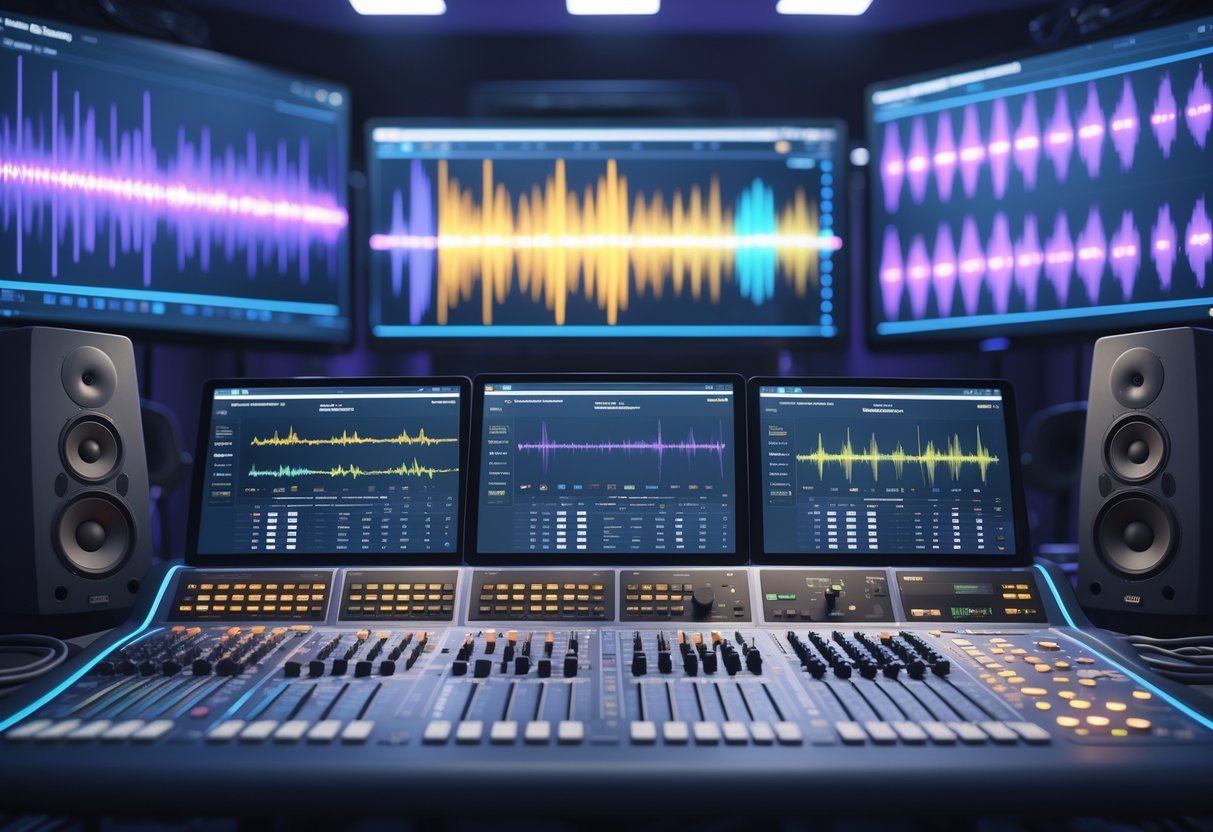
We can take simple crowd recordings and turn them into dynamic, pro-level audio with some layering and careful volume work. These tricks help esports broadcasts feel way more immersive and real.
Layering Techniques
Building up crowd sound means blending several audio elements for more depth. I usually start with a base crowd track that matches the mood.
Add layers slowly. Mix in cheering, clapping, or even whistles for those big moments. Individual shouts break up the wall of noise and keep things interesting.
Quick tip: Record different sections of the crowd separately. Layer the front-row hype with distant background murmur to get that stadium feel.
Separate your frequencies when you layer. Put rumbles in the low end, keep cheers and applause in the mids. That way, nothing gets too muddy.
Layering essentials:
- Main crowd background
- Specific reactions (cheers, gasps, applause)
- Solo voices or shouts
- Extra sounds (footsteps, seats creaking)
Don’t stack everything at the same time. Stagger reactions a bit so it doesn’t sound robotic.
Balancing Audio Levels
Good level balancing keeps crowd sounds from drowning out the main action. I usually set the crowd 10-15 dB lower than dialogue or commentary.
Compression helps tame those wild crowd spikes. Try a 3:1 ratio to keep things punchy but under control.
Heads up: Don’t squash it too much or you’ll lose the natural feel.
Always check your mix on different gear. What sounds good in the studio might be way off on a gaming headset or a phone.
Level checklist:
- Crowd sits under main audio
- Peaks hit at the right times
- Background noise stays steady
- No frequency clashes with voices
Use EQ to make room for other sounds. If the crowd and commentary clash, try cutting a bit between 2-4kHz.
Psychological Impact of Crowd Responses
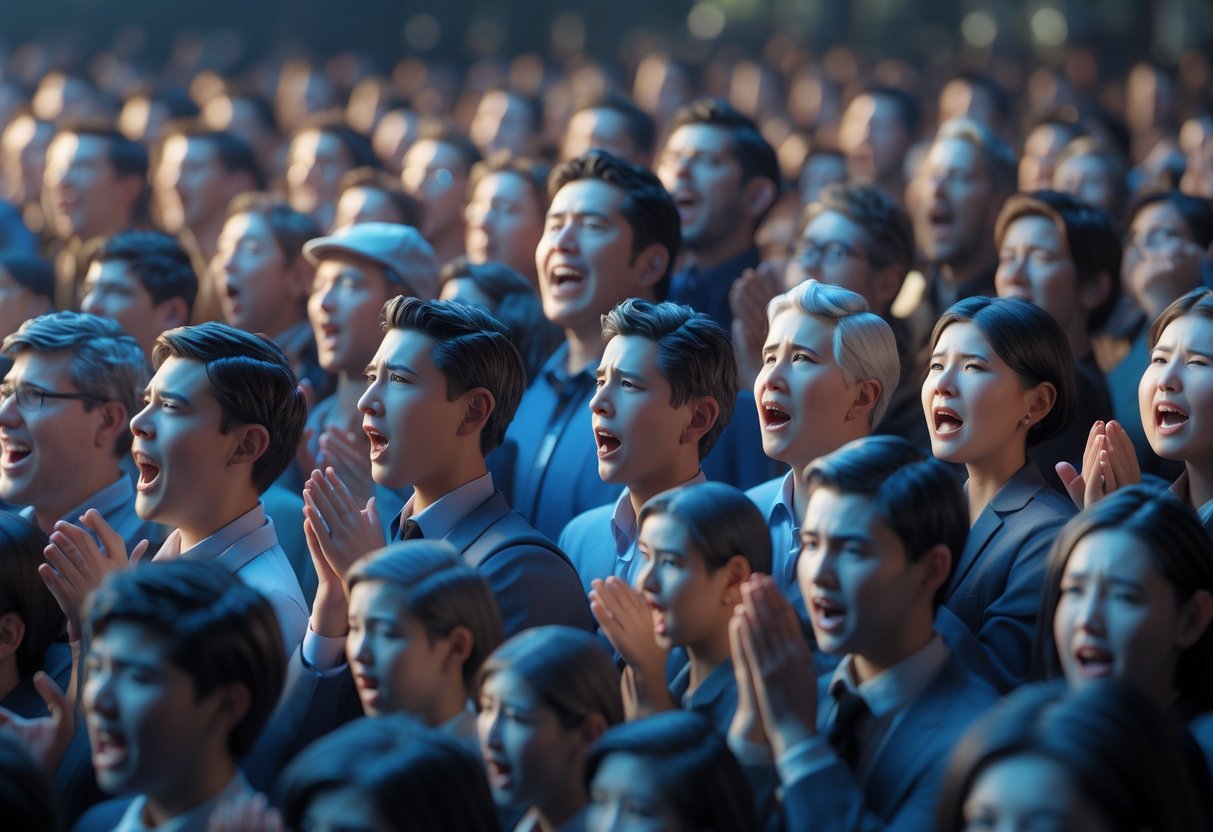
Crowd reactions seriously affect both the performers and the audience. These moments trigger emotional contagion and ramp up adrenaline, changing how everyone experiences the event.
Influence on Performers
Positive crowd energy can boost player confidence and performance—psychologists call it social facilitation. When the crowd cheers, players often get more focused and motivated.
Esports pros say they feel sharper when the audience gets loud. Their brains pump out adrenaline, which helps with reflexes and decision-making under pressure.
Hostile crowds flip the script. Players might get anxious or make rushed decisions if the audience boos or chants against them. Some say they feel totally alone when the crowd turns.
Charismatic crowd leaders can swing the mood of an entire arena. Their chants or reactions spread fast and set the tone for everyone.
Teams actually use crowd psychology to their advantage. Playing at home often means less stress, thanks to supportive fans. Visiting teams have to fight not just their opponents, but the pressure from a hostile crowd.
Audience Engagement
Emotional intensity spreads through a crowd almost instantly. One section erupts, and suddenly everyone’s joining in—it’s contagious.
People in live audiences tend to lose their individual identity. Collective behaviour takes over, and you see whole venues react in sync to big plays or bad calls.
Physical closeness makes this even stronger. Packed stadiums crank up the excitement way more than half-empty rooms. The crowd’s density boosts everyone’s suggestibility.
During tense moments, crowds become extra sensitive to outside cues. Organisers use this, timing music or lighting to get the biggest response.
Commentators and team captains can steer crowd emotions with their words and actions. Seasoned casters know how to hype up the room or cool things down when needed.
Anonymity can fuel extreme reactions. When fans wear team colours or masks, they feel less personally responsible and might act out more than usual.
Legal Considerations for Using Crowd Reactions

When you record crowd reactions at esports events, it’s important to know the legal rules for filming people. Usually, you’re fine as long as you don’t single out anyone in particular.
Pro tip: Put up clear signs at venue entrances letting folks know they’ll be filmed. This gives you implied consent and covers most legal bases.
The law treats crowd shots differently than close-ups of individuals. Wide shots of cheering fans are generally okay. If you zoom in on someone for several seconds, though, you might need their permission.
Key Legal Protections We Can Use
| Defence Type | What It Covers | Best For |
|---|---|---|
| Incidental Use | Brief, non-focused appearances | Wide crowd shots |
| Editorial Purpose | News and commentary coverage | Tournament broadcasts |
| Public Event | No privacy expectation | Open tournaments |
Heads up: Laws vary. The UK is usually more relaxed than some US states when it comes to crowd filming.
Respect people who ask not to be filmed. If someone objects, let your camera crew know right away and avoid showing them.
For esports tournaments, you don’t have to worry about religious context like at some other events. The same rules apply—if it’s newsworthy and public, editorial use is usually safe.
Best move: Add a crowd release notice to your event’s terms and conditions. Flash it on screens before matches start. This way, people can leave if they don’t want to be filmed.
Most legal headaches pop up when you use crowd shots in ads instead of live coverage. Stick to editorial use and you’ll dodge most issues.
Trends in Digital Crowd Reactions
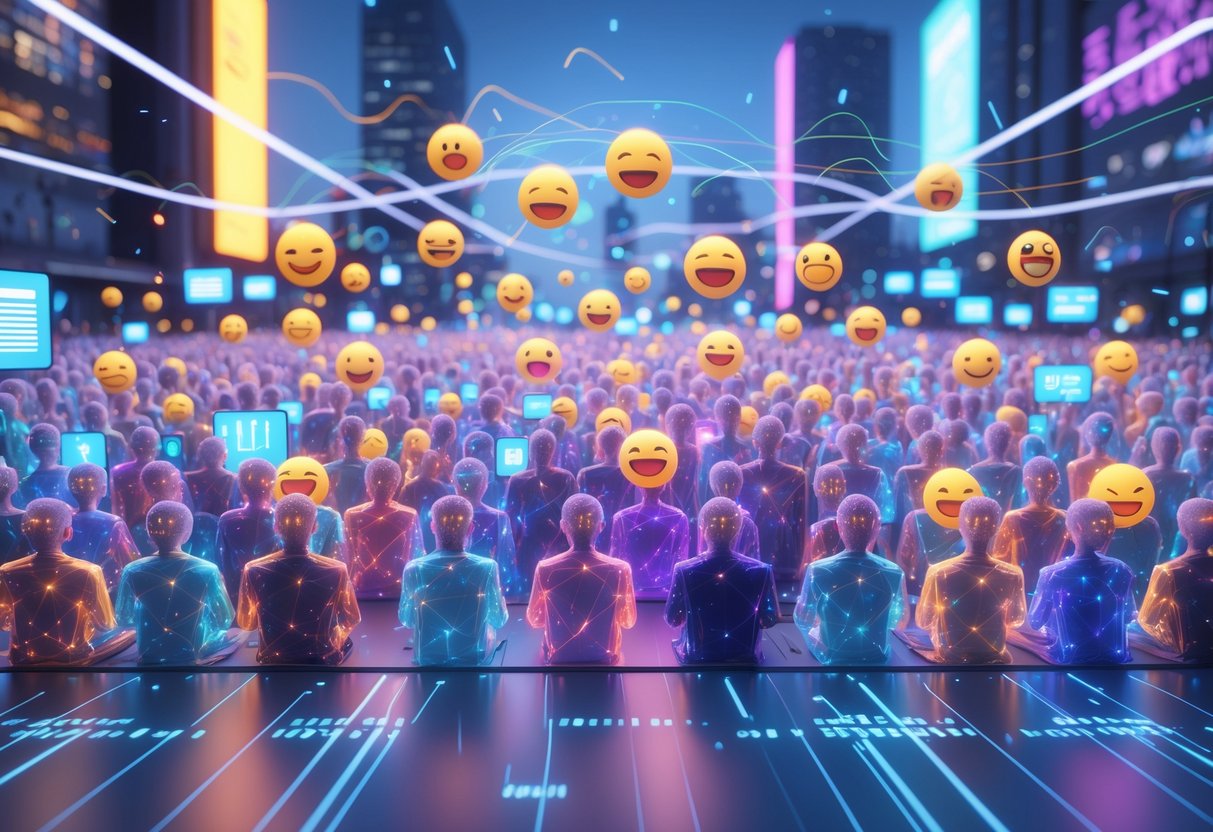
Digital tech is totally changing how we experience crowd reactions in esports. AI-generated sounds and virtual audiences are now pretty common in competitive gaming.
Synthetic and AI-Generated Sounds
Modern esports platforms use AI to craft crowd reactions that actually feel real. These systems watch the action and instantly generate sounds that fit the moment.
Machine learning powers this tech. It studies thousands of hours of real crowd audio, then spits out reactions that match what’s happening in-game.
Game studios roll out this tech in a few ways:
- Real-time analysis: AI tracks gameplay and fires off crowd sounds
- Emotional mapping: Systems match audience hype to the game’s intensity
- Dynamic mixing: Audio levels shift with the action’s importance
Popular esports games now have AI crowds that react to kills, objectives, and clutch plays. They sound natural because they’re built from real data.
Some systems even predict crowd reactions before the action unfolds. They look at gameplay trends and prep the right sounds in advance, making everything feel seamless.
Virtual Audiences
Virtual crowds are now a must-have for esports broadcasts. They keep the atmosphere lively, even when the venue is empty or limited.
Organisers rely on virtual audiences to keep energy up during online events. They’re also a solid backup when you can’t pack the stands.
Visual crowd tech creates stadium vibes that look and feel real. AI generates all kinds of digital fans, each reacting differently. The result? Crowds that seem genuinely engaged with the game.
Advanced systems pull in data from everywhere:
| Data Type | Purpose | Result |
|---|---|---|
| Game events | Trigger reactions | Realistic responses |
| Audio levels | Match excitement | Appropriate volume |
| Player cameras | Read emotions | Contextual crowds |
Broadcasters often mix virtual and real crowds. This hybrid approach keeps things exciting and gives them more options, especially for big international events with viewers all over the place.
Challenges in Capturing Diverse Crowd Reactions
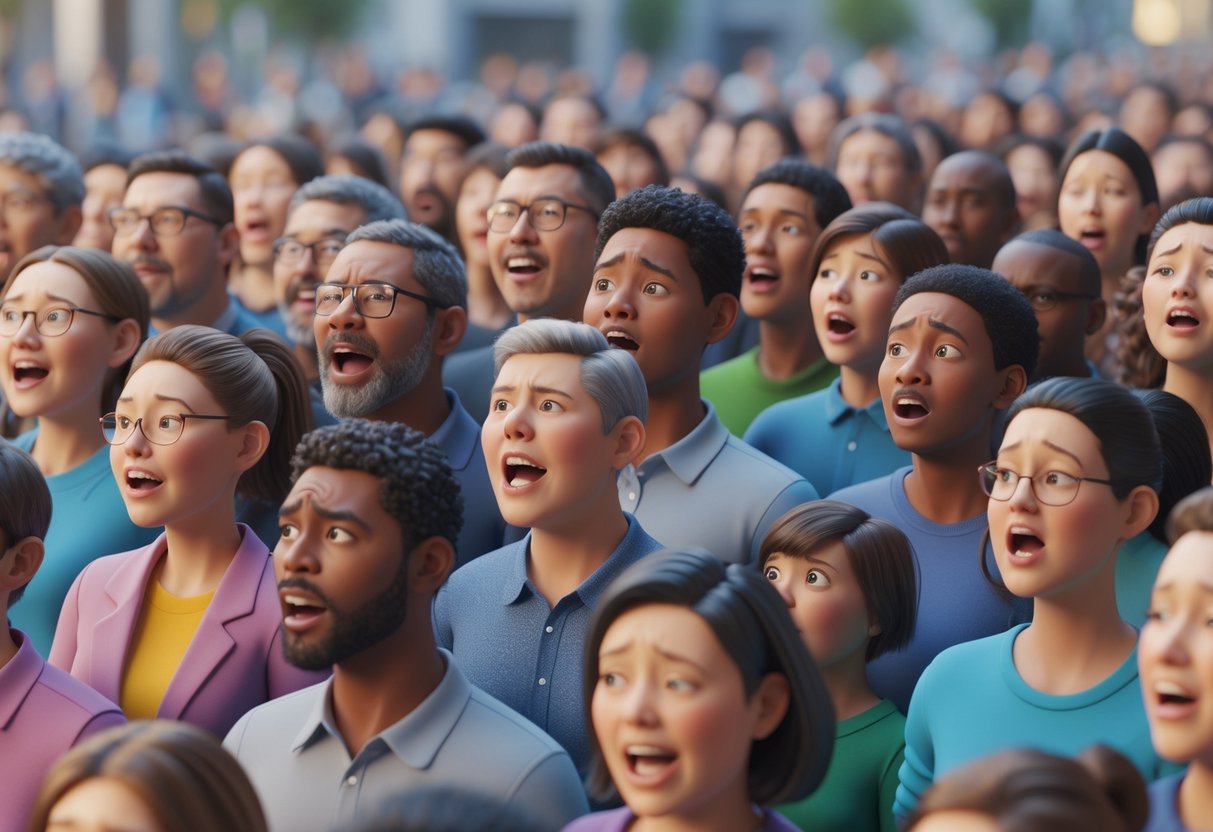
Trying to record real crowd reactions at esports events? That’s a whole different ballgame compared to traditional sports. The gaming community covers all ages, cultures, and comfort levels—and let’s be honest, some folks just hate being on camera.
Technical barriers pop up everywhere. Fans wear headsets or stare at screens so intensely that the room sometimes feels weirdly quiet.
Those moments just don’t translate well on a broadcast.
| Challenge | Impact | Typical Solutions |
|---|---|---|
| Camera shy fans | Reduced authentic reactions | Designated reaction zones |
| Cultural differences | Varied response styles | Multiple camera angles |
| Age gaps | Different energy levels | Targeted crowd sections |
Consent issues get messy fast. In traditional sports, everyone expects crowd shots—but at esports events, lots of fans prefer to stay anonymous.
Plenty of attendees stream or make their own content, which creates all sorts of rights headaches.
We’ve seen that online viewers behave differently from those at the venue. Twitch chat flies by with emotes and memes, but live crowds can look almost calm in comparison.
That gap makes it tough to show how exciting things really are.
Equipment doesn’t always help, either. Esports venues have wild lighting and massive screens that mess with camera settings.
The constant glow from monitors? It throws off exposure and makes decent crowd shots tricky.
Warning: If you try to force crowd reactions, people notice—and the gaming community can spot fake hype a mile away.
Different games, different crowds. Counter-Strike fans celebrate in their own way, and League of Legends audiences bring a totally different vibe.
If you want to capture that variety, you have to get what makes each community tick.
Quick win: Instead of wide shots, zoom in on small groups for reactions that feel way more real.
Best Practices for Integrating Crowd Sounds in Projects
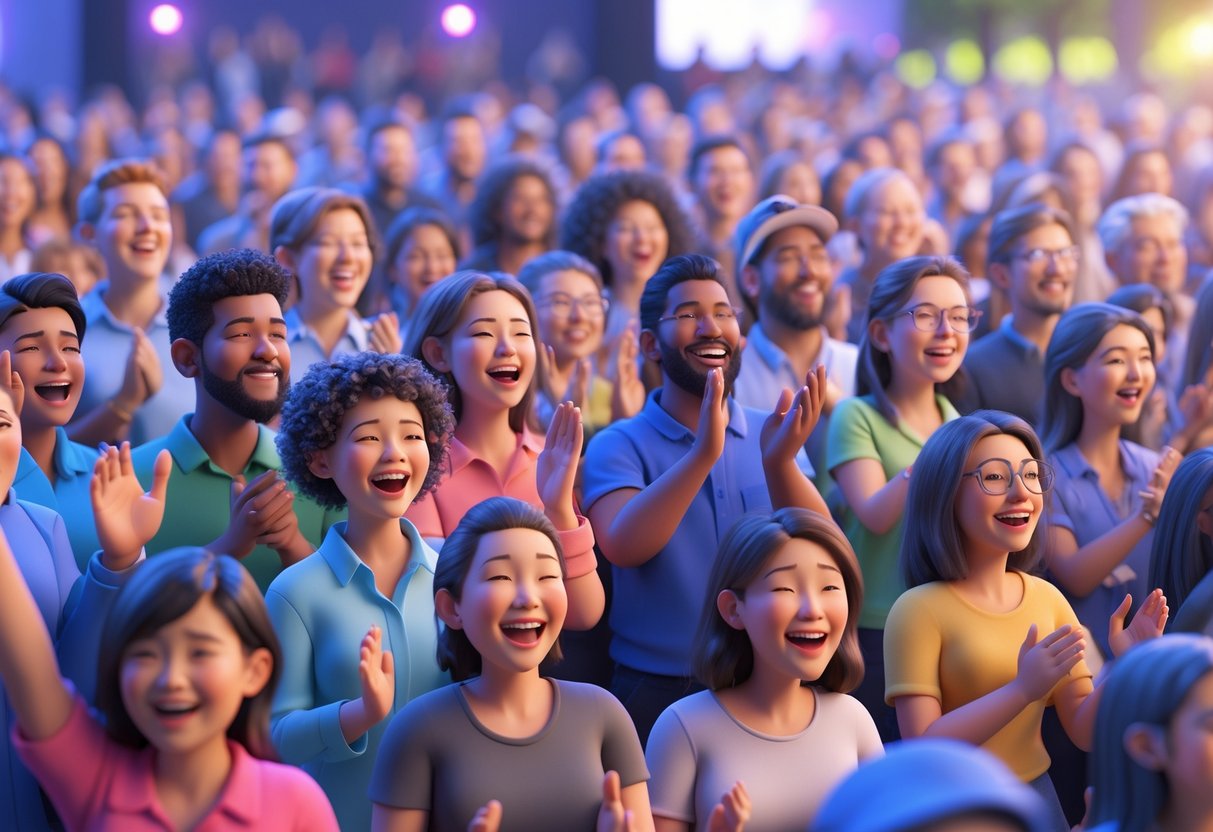
Nailing crowd sounds can make or break your project. You really want the audio intensity to match what’s on screen.
Try layering different crowd sizes. Mixing small, medium, and large samples gives your audio some life—one single recording just sounds flat.
Quick win: Grab a base layer with a few friends, then stack in pro samples for more depth.
| Crowd Size | Base Volume | Reverb Setting | Best Use Cases |
|---|---|---|---|
| Small (10-50) | -12dB | Short/dry | Indoor venues, intimate events |
| Medium (100-500) | -6dB | Medium hall | Sports halls, theatres |
| Large (1000+) | 0dB | Long/wet | Stadiums, festivals |
Timing really matters. Reactions need to hit within 200 milliseconds of the action, or it just feels off.
We always split up tracks for different emotions—cheers, boos, gasps, and even background chatter. Mixing those separately makes everything sound way more natural.
Warning: Go easy on the processing. Too much reverb or compression, and suddenly your crowd sounds like a weird robot army.
Automation curves beat static volume settings every time. Real crowds build up, then erupt—your mix should do the same.
Always check your mix on different speakers. What sounds perfect in the studio might barely register on a phone or laptop.
Frequently Asked Questions

Sports fans have always wondered about the loudest moments in history and how much crowd noise really changes the game. The energy from passionate supporters can swing everything—from a player’s nerves to the final score.
What are some of the most memorable crowd reactions at sporting events?
Leicester City’s 2016 Premier League win? That was a wild one. Fans cried, hugged, and basically lost their minds as the underdogs finally lifted the trophy at King Power Stadium.
In the 1999 Champions League final, Manchester United scored twice in injury time. The stadium’s mood flipped from heartbreak to absolute chaos in just a few minutes.
England’s 1966 World Cup victory at Wembley? Over 96,000 fans erupted as they finally brought the trophy home.
Which concert has had the record for the loudest audience?
Deep Purple set the Guinness World Record at 117 decibels in 1972 at London’s Rainbow Theatre.
The Beatles’ Shea Stadium show in 1965 came close—fans screamed so loud, the band couldn’t even hear themselves.
These days, venues keep things quieter for safety. Most places cap the volume to protect everyone’s ears.
How does crowd noise impact players during a basketball game?
Home crowds actually help teams shoot free throws better—sometimes by 3%. That familiar noise seems to boost confidence.
Visiting teams? They struggle to hear each other when it gets loud. Missed calls and botched plays happen more often.
Crowd noise spikes during big moments like buzzer-beaters. Studies even show referees call more in favor of home teams when the crowd gets rowdy.
What’s the history behind the loudest NBA crowd?
Arco Arena in Sacramento used to hold the record for loudest, thanks to its design. The sound just bounced around and overwhelmed visiting teams.
Oakland’s “Roaracle” was legendary for Warriors games. Fans there regularly hit 110 decibels or more.
Now, NBA arenas care more about fan experience than pure volume. Newer venues use better acoustics to keep things exciting without damaging eardrums.
What are the key factors that contribute to loud crowd reactions?
Stadium design matters—a lot. Enclosed spaces with low ceilings and steep stands make everything louder.
Passionate fans who sing and chant nonstop? They create the kind of atmosphere you can feel in your bones.
Big games get the loudest reactions. Finals, rivalries, and relegation battles crank up the noise.
Team performance is huge, too. When a team scores or makes a comeback, you can bet the roof’s coming off.
Can you describe the atmosphere created by a highly engaged sports audience?
When 80,000 fans start singing, the energy hits you like a wave. Players often say it feels electric—almost like the sound vibrates right through the stadium and into their bones.
People chant and sing in sync, and suddenly, all those individual voices blend into one massive roar. You can feel fans bouncing off each other’s excitement, and the noise just explodes in a way that small crowds can’t match.
The atmosphere gets intense for visiting teams. Home players, on the other hand, draw inspiration from it. Some athletes even admit that the crowd feels like an extra teammate out there.
Big, engaged crowds create unforgettable moments. Fans carry those memories for decades, and these experiences end up woven into the club’s story.

